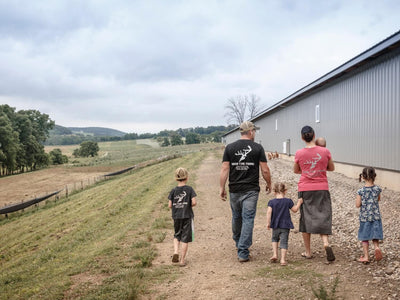
Understanding the Emergency Relief for Farmers of Color Act
Pete & Gerry's is proud to support the Emergency Relief for Farmers of Color Act. Read on to understand more about what this bill hopes to address, along with ways you can help.
There is a well documented, indisputable history of discrimination in the farming industry, and it has led to a steep decline in Black farmers in the past century. Those who have survived, now have less land and more debt. Systemic inequity carried out through subsidy denials, delayed loans, and lack of access to support continues today. Grassroots organizations like The National Black Farmers Association (NBFA) have been working tirelessly to reverse the effects of racial discrimination in agriculture, but even now, they're up against deep-seated policies and a landscape of systemic inequity. A new act introduced by Georgia Senator Raphael Warnock could be a crucial top-down move towards justice and reparations for Black farmers and other farmers of color who haven't been given a fair chance in this country.
A history of discrimination against Black farmers
Farming is a labor of love. A tireless job. Our own story is not without some hardship: in fact, Pete & Gerry's was almost forced out of business by the booming factory farm industry in the 1980s, and had our family not worked day and night to overcome, we would no longer exist. Add any other layer of disadvantage, and you've got a recipe for endless struggle, loss, and disaster. John Boyd Jr., a third generation farmer and founder of NBFA said it best: "It's tough for all farmers, but when you throw in discrimination and racism and unfair lending practices, it's really hard for you to make it."
Thanks to organizations like NBFA and the Environmental Working Group (EWG), our country's history of discrimination against Black farmers is well documented and increasingly visible to the public. And for decades, the United States Department of Agriculture (USDA) has been the catalyst of this discrimination, enforcing racism in the industry via withholding or delaying the benefits, money, and support from Black farmers––the same resources that have historically been provided to white farmers. In collaboration with NBFA, EWG recently released a timeline that maps the relationship between Black farmers and the USDA from 1920 to 2021. Their findings? A century of calculated, unjust discrimination rooted in racism and carried out under the guise of legislation. The numbers say it all: according to the timeline (and the USDA's own data), there were 925,708 Black farmers in the United States in 1920. In 2019, there were just 45,000. The relationship between 100 years of racial discrimination by the USDA and a stark downward trend in the number of Black farmers in America is one of cause and effect.
Systemic inequity: displacement, subsidy denials, delayed loans, and lack of support
The past century of America's history has been riddled with racial discrimination in the agricultural sector, thinly veiled in legislation and policy. True, small family farms have historically lacked proper support from our government (regardless of race, many farmers still struggle to make a living today), but there exists substantial, specific evidence that farmers of color, and especially Black farmers, have been the target of such discrimination. From the physical displacement of Black farmers from their land to the unfulfilled promises of bailouts and subsidies, this undeniable line of racial discrimination can be traced back through decades of American history.
Case study: the displacement of Black farmers
The New Deal of 1933, one of the first documented cases of racial discrimination masquerading as law in agriculture, displaced Black farmers who had acquired land after the Civil War. At the time, it was believed that supply and demand were out of balance, resulting in too much product at too low a cost. The Agricultural Adjustment Administration, a New Deal program, aimed to cut back farm production in order to raise prices. This desired effect was to be achieved by subsidizing farmers who agreed to reduce their output. While this program was aimed at giving the entire agricultural industry a leg up, it forced many already struggling Black farmers to sell their land and pursue another means of survival. In a country where land is one of the most valuable forms of intergenerational wealth, this mass displacement of Black farmers set a precedent for the subsequent generations of Black Americans, farmers or not.
Case study: racially-motivated denial of access to support, services, and positions of power
In 1965, a report by the U.S. The Commission on Civil Rights posited, with extensive research and evidence, that the USDA discriminated against Black farmers when providing loans and conservation payments. Titled Equal Opportunity in Farm Programs: An Appraisal of Services Rendered by Agencies of the United States Department of Agriculture, the report states that at the time, thousands of Black farmers were "denied access to services provided to white farmers which would help them to diversify, increase production, achieve adequate farming operations or train for off-farm employment" that "with few exceptions, [Black farmers] are not appointed as full members to county committees by the FHA but are confined to a newly created category of special alternate membership" that Black farmers "in southern counties generally receive less service from the SCS" than their white counterparts, and that Black farmers were not just underrepresented, but absent from the nearly 5,000 people serving on Agricultural Stabilization and Conservation Service (ASCS) committees in 11 Southern states. This last finding is perhaps the most consequential of them all, as the ASCS, an agency under the USDA, was once in charge of granting loans to farmers and overseeing the usage and distribution of farmland under quota programs.
Case study: unfulfilled promises to Black farmers
Despite - or perhaps as a result of - decades of legislation aimed towards helping the struggling American farmer, the population of Black farmers in the United States had fallen exponentially by the turn of the century. Black farmers continued to speak out for justice and equity, a fight most notably manifested in Pigford v. Glickman, a class action discrimination lawsuit between the USDA and Black farmers. In 1999, the Pigford case reached a settlement of $1.03 billion to be paid out to Black farmers. According to a report by The United States District Court for the District of Columbia, although more than 22,000 Black farmers filed claims, only 15,645 were compensated. Of the 61,000 Black farmers who filed late claims, only 2,585 were accepted. While the historic case was a monumental step towards widespread recognition of racial discrimination in American agriculture, the settlement and follow-through by the USDA was lacking; an unfulfilled promise.
Top-down reparations and grassroots solutions
Today, a combination of top-down legislation and continued support from grassroots organizations is our country's best chance for enacting change and following through on reparations for Black farmers.
What is the Emergency Relief for Farmers of Color Act?
In early 2021, Senator Raphael Warnock introduced the Emergency Relief for Farmers of Color Act. If passed, the bill would provide $5 billion in direct relief, debt forgiveness, and land to Black, Indigenous, and Hispanic farmers and other agricultural producers of color to help them respond both to the devastating consequences of the pandemic and longstanding discrimination in agriculture. As evidenced by a history of racial discrimination, farmers of color have been put at an overwhelming disadvantage initiated from the top down, whether via legislature or the USDA's policies and actions. Therefore, reparations must also be top-down, and it's important that these legislations include tangible, monetary benefits.
The Emergency Relief for Farmers of Color Act proposes "$4 billion in direct relief payments to help farmers of color pay-off outstanding USDA farm loan debts and related taxes, and help them respond to the economic impacts of the pandemic," plus a "$1 billion fund to support activities at USDA that will root out systemic racism, provide technical and legal assistance to agricultural communities of color, and fund under-resourced programs that will shape the future for farmers and communities of color." This fund will be utilized to improve land access, address heirs' property issues, provide support to legal centers dedicated to assisting farmers of color, assist farmers of color with land acquisition and the financial and technical facets of the process, establish a racial equity commission to address systemic racism in the USDA, support Historically Black Colleges and Universities, and much, much more. The bill would be one of the first steps in creating an equitable industry and diversifying farm networks like the one that Pete & Gerry's is built upon.
What is the National Black Farmers Association?
In the organization's own words, the National Black Farmers Association (NBFA) is "a non-profit organization representing African American farmers and their families in the United States. As an association, it serves tens of thousands of members nationwide. NBFA's education and advocacy efforts have been focused on civil rights, land retention, access to public and private loans, education and agricultural training, and rural economic development for black and other small farmers." Founded in 1995 by John W. Boyd Jr., a fourth generation farmer and longtime voice for Black farmers, the organization has made tremendous strides in the fight for civil rights and justice in agriculture. The NBFA not only communicates and educates, but assists disadvantaged farmers in navigating and accessing vital state and federal resources. In the past nearly three decades, the organization has mobilized farmers and citizens in the call for change, and today, voicing and garnering support for legislation such as the Emergency Relief for Farmers of Color Act.
How can I help uplift Black farmers?
Change can start anywhere, but the most impactful, lasting changes in our country come from collaboration. In this case, tangible change will require both grassroots efforts and action at the federal level. So use your voice to speak up for the change you believe in: call on your elected officials for their support of the Emergency Relief for Farmers of Color Act today, start a conversation with friends or family, or take time to become better educated on histories of our country that are far too often overlooked.



